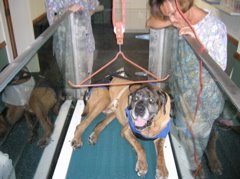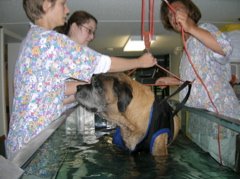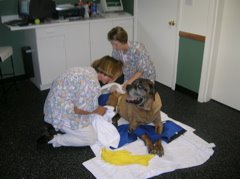Goya's first bout with coonhound paralysis occured in the summer and he and we could sleep outside. He also was stronger, and could drag himself across the grass, or to Bonnie's dismay the driveway.
This time it was December. In Pittsburgh, it is cold in December. He also lost contol of much more of his body. For example, he couldn't hold his head up. Everytime we took him to the vet he would urinate at the vet. Maybe he was trying to tell us something, maybe not. By the time we got home from Ohio State, we weren't planning on going to the vet every day. We also couldn't leave Goya out in the cold.
The vets at Ohio State recognized that this would be an issue and gave us a 5 minute lesson in daily urinary cathetorization. They then sent us home with a set of catheters, purple latex gloves (too small for Gary, and too large for Bonnie, but one size fits all). We were supposed to cathetorize Goya twice a day. The procedure was to expose the penis, and slip the catheter in until urine starts to come out. We should expect at least 1 liter of urine a day.
We ended up taking Goya to the Orthopedic Vet the first weekend, mainly because we just weren't ready to handle a 150 lb dog who couldn't walk. We needed the weekend to get our house ready to handle getting him out, and just sleeping in the livingroom. The local Orthopedic vet had a different opinion about urinary catheters, and we decided to follow his advice.
His advice was to put in a "permanent" catheter. A permanent catheter has a small balloon at the end. The catheter is inserted (by a vet-tech) and the balloon is blown up. I think the balloon is about the size of a marble when blown up. The balloon serves two purposes;
- It keeps the catheter tube in the bladder because the balloon is larger than fits through the urethea.
- It blocks the urethea from being a pathway for urine.
Ohio State thought that permanent catheter's were pathways for infection. Thus it was better for the dog to use a sterile use-once catheter every time.
Our orthopedic vet thought that permanent catheters were safer. His thinking was based upon his opinion that novices (like us) couldn't be careful enough to not introduce infections with the use-once catheters. Also the possible bacteria in our home were not as dangerous as the bacteria at the vets. So Ohio State was not considering the at-home aspects in their risk/benefit tradeoff.
We were incompetent to really judge the issue. So we selected our orthopedic vet's view as correct because it meant we had less to handle with an already difficult situation. However, this decision had implications we didn't forsee.
Before getting into the implications, I wanted to describe the apparatus. Goya has a thin white tube going from a bulbous piece into his penis and up to his bladder. The bulbous piece has a component that one can hook a syringe to, and using the syringe blow up a balloon at the end of the tube that is in his bladder. You can also use the syringe to deflate the balloon. Attached to the bulbous tube is another tube (about 6-15 feet long) that ends in yet another bulbous device that can attach to an IV bag. The IV bag fills with urine and can be detached easily. We detach the IV bag about once a day, to empty it. Goya produces about 800ml-1,500 ml of urine a day.
The first implication was that the urine wasn't always clear. Bladder infections were occuring. It was never clear that they were more/less prevalent because of the permanent catheter. However, we had to give antibiotics to Goya to handle the bladder infections. After 3 months we had a different vet come to our house, and he looked at the urine and said "lots of sperm in that urine". Thus we (and some of our vets) may have been interpreting unclear urine incorrectly. However, the vets were inspecting the urine with a microscope and counting bacteria, so my guess is we were doing most of the mis-interpretation. Goya has been on 4 treatments of antibiotics, and is about to start another.
The second implication is that we had to be careful with the handling of this tube. The first time we had a problem, occurred because I wasn't careful at about 3AM when Goya wanted me to roll him over. The tube for some reason wasn't free, and rolling him over caused his weight to pull the tube (with the balloon) into his uretha and block his uretha, and the tube. We had to go to the orthopedic vet the next day.
The vet replaced the permanent catheter and, chastized us for not collecting 2 liters of urine a day (thus we weren't forcing enough water down his throat). This chastizing pissed me off because we were making water available to Goya all the time, he just didn't want to drink it. Did the vet give us any instruction as to how to get him to drink 2 liters of water a day? NO. We were documenting what he drank (about 1 liter) , and it approximately equaled his urine production. Were we to squirt water down his throat? Hold him down in a tub? We had no idea, so we ignored the vets concern. Later when we got a vet to come to our house, this new vet was very comfortable with the amount of liquid that Goya was processing. We still don't know which vet is right, but we also don't know what we could do to get Goya more water.
Goya had one other time when the permanent catheter partially came out. At that time, we decided to try the at home vet solution because taking Goya to the vet was both hard on us (and I had broke my shoulder) and hard on Goya.
The at home vet was APALLED yes APPALLED that we had left the permanent catheter in for so long. Also Goya had a bladder infection. He left us with instructions on replacing all the equipment that attached to the catheter every week. He also left us equipment for replacing the current tubing and IV bag. He also put Goya on a round of Cipro.
Goya now seems to have his bladder infection somewhat under control. The vet thinks he needs another couple of weeks of antibiotics. He is still urinating at about 1 liter /day.
The only other issue I didn't discuss is that we have to tape the catheter to Goya, so that it doesn't flop about, and so it doesn't get kinks. We sliced some aquarium air tube and placed it over the relatively thin catheter tubing so that the air tube supported the catheter tube around bends, and the catheter tube didn't kink. However, we haven't figured out a good way to tape the bulbous catheter dohicky to Goya. The problem seems to be that the white bandage tape is optimized to not hurt humans when pulled off, and thus doesn't stick well to hair. Goya is covered in hair. His stomach is also more narrow than his rib cage, so the entire device and tape belt slides down his body. We need stickier tape, and haven't found any at any of our drug stores. Alas always problems. If stickier tape is the worst problem, then life isn't so bad.









